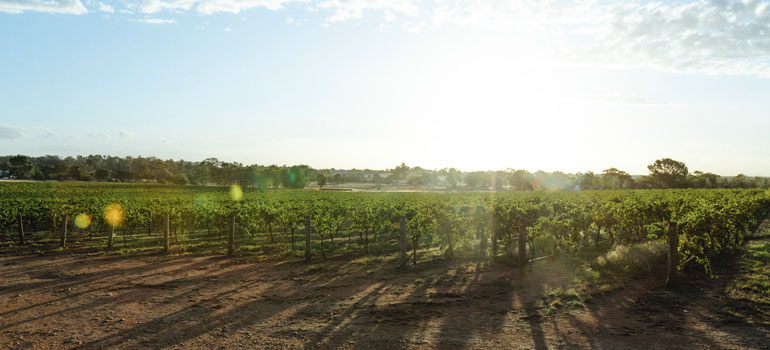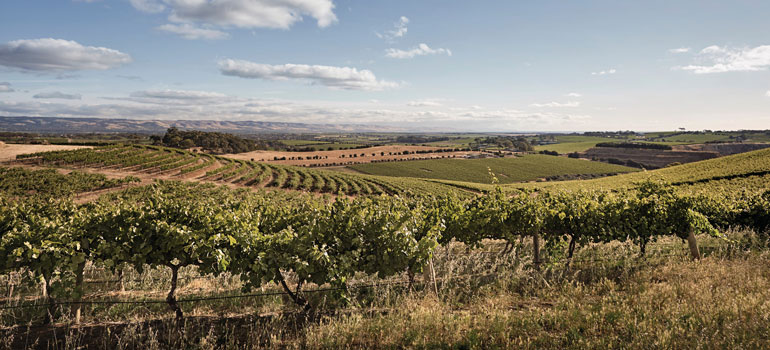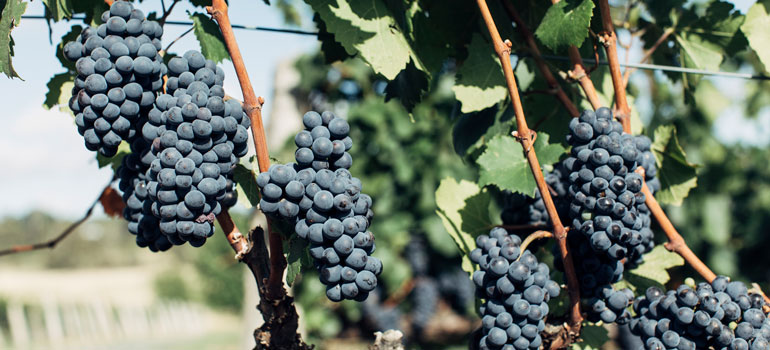Wine Australia’s Australia’s Wine Future: A Climate Atlas, was released in 2020, following three years of research by the University of Tasmania’s Climate Futures team.
The Atlas provides a range of viticulture specific indices to model changes to the climate, in 10 year increments out to 2100 for each of Australia’s 65 wine regions.
The project identified weather risks that are particularly important to grape growing and assessed future changes in their frequency and intensity based on regional climate models that incorporate the large-scale climate drivers impacting drought and extreme heat.
The indices include rainfall, rainfall timing, aridity, heat accumulation and the likelihood of heatwaves and frost.
In addition, the Atlas indicates the regions around the country that are similar now to projected conditions. This allows growers and winemakers to look to their peers and viticultural experts in analogue regions for ideas on how to adapt for their future.
The Atlas was intended to inform decision-making for the grape and wine sector and since its release different regions and businesses have been using it as a strategic tool to inform their future planning.
This article outlines the ways in which a number of different wine regions and wine companies have used the Atlas to date.

North East Victoria
Lachlan Campbell from the North East Victoria Wine Zone said his region had approached the Atlas as a vehicle to support future planning and decision making. They organised a series of seminars for the four distinct sub-regions King Valley, Alpine Valleys (including Glen Rowan), Beechworth and Rutherglen, which were attended by more than 80 people.
The seminars brought in viticultural experts Professor Snow Barlow and Ben Rose to provide a sense of what the climate changes predicted in the Atlas mean in terms of viticultural practice.
For the North East Victoria region, the Atlas broadly predicts more heatwaves, slightly less rain overall and more summer rain. The consequences are likely to mean earlier harvesting – due to the additional heat degree days and hotter conditions – but more critically for the region, where many grape crops were affected by smoke damage from fires in 2020 and 2021, there is concern about the increased potential for fire events close to vintage.
“Our region sees the Atlas as a great tool to unpack the local impact of climate change,” Mr Campbell said.
More summer rain will mean more disease pressure and we can look at how we will adapt our management to deal with that.
“We can plan how to deal with more arid conditions, better soil moisture management and scheduling, and there is a lot of conversation around new varieties.
“There’s no money to talk about completely new plantings but people are talking about reworking to warmer Mediterranean vine types such as Nero d Avola and Fiano.”
Mr Campbell said the horizon that was being used from the Atlas depended on the enterprise and to some extent on the age of the grapegrowers.
“Growers in their sixties are less likely to make big changes. It’s the younger generation that will make changes, they bring new energy and capacity, whether they are descendants of the original growers or new entrants.

“Climate change is something that everyone is dealing with. The past 20 years have seen change already,” he said.
The region was successful in obtaining support from the Victorian State Government to plan for its future and will conduct two more workshops where the region will be able to drill down into the information in the Atlas.
“It’s a useful resource but also a very dense document and unpacking it is a challenge. You need diversity in the room and a collective approach.”
Limestone Coast
The Limestone Coast region has taken a somewhat different approach and is dealing, as might be expected, with slightly different issues.
Hans Loder of Penley Estate, who chairs the region’s technical committee, said that more than 10 years ago the Limestone Coast Grape and Wine Council had put together a document, Unearthing Viticulture, drawing together information on geology, geomorphology, soils and climate as they relate to viticulture in the region. This has provided a valuable resource in terms of summarising climate indices for each of the sub-regions of the Limestone Coast, which can now be compared to predictions detailed in the Climate Atlas.
One workshop has already been hosted in the Limestone Coast featuring the Atlas, on the topic of managing extreme weather events. Positive insights from the day were a predicted reduction in frost days for the region and similarly, a buffering to the worst shifts in mean temperature, on account of proximity to the coast.

However, both Mr Loder and Ulrich Grey-Smith, of the Limestone Coast Wine Association, felt that in relation to climate change, it was not just the underlying warming trend that one needed to understand. Extreme weather events remain a primary risk factor and the Climate Atlas had been useful in flagging the future probability of these extremes.
Further workshops using the Atlas are planned to coincide with training workshops for Sustainable Winegrowing Australia certification. Mr Loder and Mr Ulrich Grey -Smith see synergies in understanding the influence of climate change on a region and that this intuitively goes hand in hand with sustainability.
They point out that, even if we ‘collectively as a planet’ achieve current emissions targets, the Intergovernmental Panel on Climate Change (IPCC) currently predicts that this will still result in a 1.5C increase in mean global temperature by 2030.
The Atlas can be used to understand the impact of this unavoidable change in terms of viticulture-specific indices, which allow consideration of adaptive management strategies around irrigation, canopy management and all the way through to the way winemakers manage grape intake (compressed vintages), fermentation management and wine styles.
They regard the Atlas as a significant tool to raise awareness of the impact of climate change and encourage adaptation. The Atlas does not hold answers but is a critical tool in informing thinking and planning for the region, particularly around the region’s dominant variety of Cabernet Sauvignon. Mr Loder expects that individual businesses will have their own approaches to addressing the changes flagged by the Atlas, which will likely extend beyond current management of seasonality.
Mr Loder said that importantly, the Atlas is a readily available document that allows grapegrowers and winemakers to contextualise climate developments in industry relevant ways.
McLaren Vale
Rachel Williams, formerly McLaren Vale Grower Engagement Officer said the region had found the Atlas’ predictions particularly useful in dealing with government agencies over long-term regional plans.
The region has been working with key stakeholders, such as SA Water and the Willunga Basin Water Company, on a long-term regional water security plan. The comprehensive data on climate impacts in the Atlas had been equally useful in working on groundwater management with the Landscape Board (which replaced the former Natural Resource Management Boards) and Department of Environment.
She said having an authoritative resource with region-specific information had made it much easier for the region to work closely with various agencies on long-term planning.
Ms Williams said that the drying trend flagged in the Atlas had also highlighted that there was a need to work out how to deal with an increase in prescribed burns in autumn which could potentially clash with grape ripening. Identifying this as an issue will allow time to consider solutions.

The Atlas is also being used widely as a reference when people are discussing ongoing vineyard management such as reworking vineyards or managing soil health via under vine cover cropping, as well as in resilience plans. Ms Williams said most people in the region are referring to a 20-to-50-year window within the Atlas as being the latitude of current planning horizons.
Yalumba Family Wines
Chief viticulturist with Yalumba Family Winemakers, Robin Nettlebeck, said the Atlas had become a crucial part of the company’s decision-making suite.
He takes it a step further and suggests that the Atlas should become a standard used in all viticulture and winemaking courses and should be one of the basic resources examined when either buying a new vineyard or planning a new vineyard.

“Viticulturists or winemakers considering taking up a new position in a different region should background themselves with the Atlas to get an idea of what they will be dealing with in the future,” he said.
“Reviewing the Atlas summary for a region or regions is now an essential part of any investment-related process for Yalumba and plays a critical part in forward planning.”
As a family business looking forward for the next generations, Mr Nettlebeck said Yalumba reviewed its critical decisions on short, medium and long-term basis. Some investor-backed businesses might review things on shorter horizons but even for them, he thought it was an important tool for business.
“In the past, it was difficult to find information, and detective work was required to get a handle on future implications. The Atlas has brought everything together in one source of truth, removing the struggle to find climate information across a range of sources.”
The Atlas has served as a useful tool in several different ways at Yalumba.
For example, an assessment report prepared for the company Board on regional water run-off was informed by the Atlas. If only, Mr Nettleback said, there was something equivalent for the whole of the Murray Darling Basin!

The Atlas is also underpinning decisions on varieties, reworking and trellising, even trellising direction.
He said as it was extremely unlikely that Yalumba would move its vineyards, (not withstanding its investment in Tasmania) there were still plenty of techniques in the vineyard management arsenal that could be used to increase vineyards’ resilience in the face of climate change.
Mr Nettlebeck said John Gladstone’s seminal work on climates and vineyards had been an extremely useful tool for the Australian wine sector in the past (and needed updating), but he was confident that the Atlas would be viewed in the same way in the future.
Thanks to the Australian Society of Viticulture and Oenology for working with us on the preparation of this case study.
